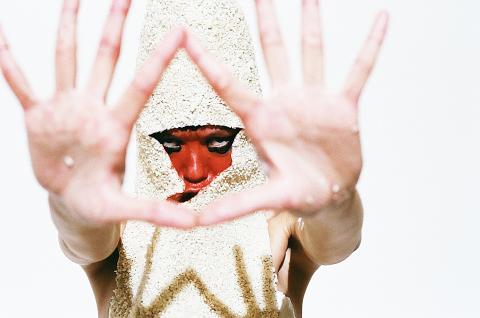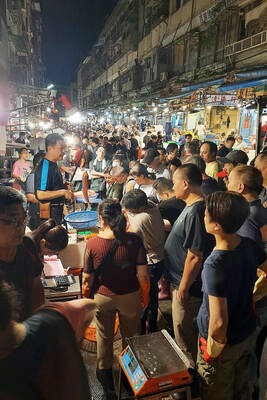On Saturday next week, Urban Nomad Film Festival begins proceedings with a party. The lineup includes Taiwanese American DJ Mochipet on his first visit to Taiwan. Hailing from San Francisco, the glitch-hop and dubstep artist is heavily into bass and dresses like a purple dinosaur.
He’ll be joined by Taiwan’s own Funky Brothers (who perform with between eight to 10 members on stage at any given time), DJ Marcus Aurelius, and the electro-diva grrrls of Go Chic, which has toured extensively and is producing an album in Berlin with the help of Canada’s foremost electro artist Peaches.
Headlining the night is Japanese art-dance-fashionista-freaks Trippple Nippples. Think Lady Gaga triplets crossed with gross-out band Gwar, and you still aren’t even close.

Photo courtesy of Takeru Kihara
The three lead singers of the band make their own costumes, which have included rotten spaghetti and latex dresses, and rice encrusted headgear and body armor, by hand.
“The process we take while we are making the costume, etc, is the most uncolorful, sweatshop-ish part,” said band member Orea Nippple. “It’s like Third World, but we love it so I guess we can’t complain.”
The group’s wild stage antics and messy costumes have had them kicked out of various venues. “You should think about how you could mess us up rather than worrying about how you can get away from getting messed up,” warned Yuka Nippple, who describes the group’s music as “headache and stomachache and strawberry ice cream.”

The Taipei Times last week reported that the rising share of seniors in the population is reshaping the nation’s housing markets. According to data from the Ministry of the Interior, about 850,000 residences were occupied by elderly people in the first quarter, including 655,000 that housed only one resident. H&B Realty chief researcher Jessica Hsu (徐佳馨), quoted in the article, said that there is rising demand for elderly-friendly housing, including units with elevators, barrier-free layouts and proximity to healthcare services. Hsu and others cited in the article highlighted the changing family residential dynamics, as children no longer live with parents,

It is jarring how differently Taiwan’s politics is portrayed in the international press compared to the local Chinese-language press. Viewed from abroad, Taiwan is seen as a geopolitical hotspot, or “The Most Dangerous Place on Earth,” as the Economist once blazoned across their cover. Meanwhile, tasked with facing down those existential threats, Taiwan’s leaders are dying their hair pink. These include former president Tsai Ing-wen (蔡英文), Vice President Hsiao Bi-khim (蕭美琴) and Kaohsiung Mayor Chen Chi-mai (陳其邁), among others. They are demonstrating what big fans they are of South Korean K-pop sensations Blackpink ahead of their concerts this weekend in Kaohsiung.

Taiwan is one of the world’s greatest per-capita consumers of seafood. Whereas the average human is thought to eat around 20kg of seafood per year, each Taiwanese gets through 27kg to 35kg of ocean delicacies annually, depending on which source you find most credible. Given the ubiquity of dishes like oyster omelet (蚵仔煎) and milkfish soup (虱目魚湯), the higher estimate may well be correct. By global standards, let alone local consumption patterns, I’m not much of a seafood fan. It’s not just a matter of taste, although that’s part of it. What I’ve read about the environmental impact of the

Oct 20 to Oct 26 After a day of fighting, the Japanese Army’s Second Division was resting when a curious delegation of two Scotsmen and 19 Taiwanese approached their camp. It was Oct. 20, 1895, and the troops had reached Taiye Village (太爺庄) in today’s Hunei District (湖內), Kaohsiung, just 10km away from their final target of Tainan. Led by Presbyterian missionaries Thomas Barclay and Duncan Ferguson, the group informed the Japanese that resistance leader Liu Yung-fu (劉永福) had fled to China the previous night, leaving his Black Flag Army fighters behind and the city in chaos. On behalf of the